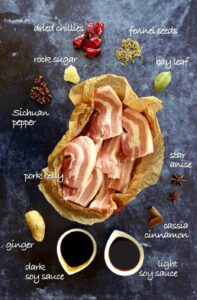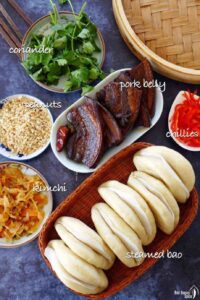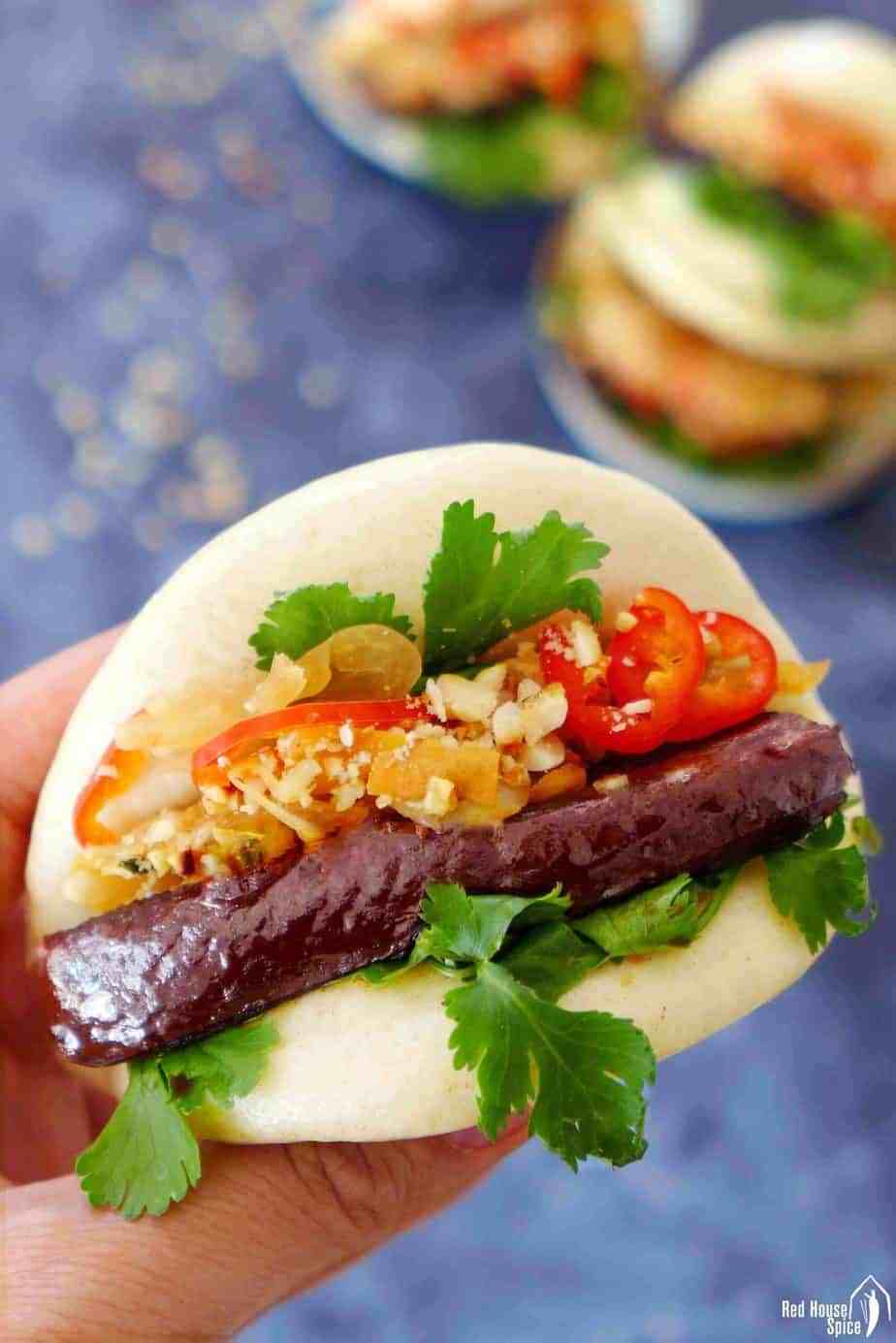GUA BAO (PORK BELLY BUNS, 刈包) Recipe
WHAT IS GUA BAO
Gua bao (割包/刈包), also known as “pork belly buns” (or simply “bao”), is a popular street food which originated from Taiwan. It consists of a flat steamed bun folded halfway to hold a piece of braised pork belly, typically topped with some fermented vegetable, ground peanuts, coriander, etc.
Many Chinese restaurants serve this type of steamed bun (known Hé Yè Bǐng, lotus leaf buns) on their own. So you can stuff them with any savoury dishes on the table.
The introduction of Gua Bao on Wikipedia explains in detail the history and current trend of this delicacy. Go have a read if you’d like to learn more.
HAVE A GOOD WORKFLOW
There are several preparation and cooking processes involved in the making of Gua Bao. So it’s quite important to have a good workflow. Here is the procedure that I follow:
- Braise the pork belly first. It takes a little over 1 hour if using a regular stove-top pan.
- While the pork is simmering, prepare the dough and shape the buns. Then leave them to rest for 30 minutes or so.
- During this half an hour, prepare the other fillings for Gua Bao: kimchi, peanuts, coriander, fresh chilli, etc.
- Then steam the buns. It takes about 12 minutes from boiling the water to finish steaming.
- By then, the pork belly should be tender enough to serve. You are ready to assemble Gua Bao and enjoy!
HOW TO BRAISE THE PORK BELLY
A classic filling for Taiwanese Gua Bao, pork belly slices are seasoned with various spices and cooked to a melt-in-your-mouth texture. The cooking method is very similar to Chinese red-cooked pork. It takes three simple steps:

- Firstly fry the pork belly in a little oil until it gains a lovely golden colour on both sides.
- Then add all the spices and seasoning. Cover the pork with hot water.
- Leave it to simmer over low heat for about 1 hour until fork-tender.
- SPICES & SEASONINGS
- You will need a piece of ginger. Remove the skin then smash it (with the side of a cleaver) to fully release its flavour.
- The spice list includes star anise, cassia cinnamon, Sichuan pepper, fennel seeds, bay leaf & dried chillies. You might not have all of these in hand. Please feel free to skip one or two if unavailable.
- Use both light and dark soy sauce. The latter gives the pork an appetising brown colour. I also add a piece of rock sugar to balance the saltiness (regular sugar is fine too).
OTHER FILLINGS & THEIR SUBSTITUTES

Apart from pork belly, classic Gua Bao involves a few other fillings that add extra flavour and texture to the dish. Based on the popular choices, my recipe also has some of my own twists. Here are the items I use:
- Kimchi, Korean fermented Napa cabbage. This is a substitute for stir-fried Suan Cai/酸菜, Chinese pickled mustard greens, which is often found in classic Gua Bao. Please feel free to use any pickled vegetables that you like (eg. German sauerkraut). The saltness and fermented flavour helps to reduce the greasy taste of the pork.
- Toasted & crushed peanuts. They add a hint of smoky, nutty aroma and a little crunch to the dish. Alternatively, you can go for the traditional version which calls for ground peanuts mixed with a little sugar. Please feel free to use other nuts if you like, such as cashew nuts, walnuts, etc.
- Coriander. This can be replaced by basil, scallions, or lettuce leaves.
- Fresh chillies. Their vibrant colour makes Gua Bao even more appetising. If you have a low tolerance of heat, choose mild ones or simply skip them.
HOW TO MAKE THE BUNS
AN EASY DOUGH RECIPE
For Gua Bao, I adopt my dough recipe for Mantou (plain steamed buns) and Hua Juan (flower rolls). It’s quick and easy, ideal for those who aren’t familiar with making leavened dough. For making 8 buns, you will need:
- 300g all-purpose/plain flour
- 1 tsp instant dry yeast
- 1 tsp baking powder
- 1 tsp sugar
- 155ml lukewarm water
FOUR STEPS TO FOLLOW
- Combine all the ingredients then knead into a medium-firm, smooth dough. You can achieve this by hand or using a stand mixer with a dough hook.
- Divide the dough into 8 parts. Flatten each piece into an oval shape then fold over. Don’t forget to place a piece of parchment paper in between.
- Rest the buns for 30 mins. The time required may vary a little. Well-rested buns should be slightly bigger but not double the size.
- Steam the buns for 10 minutes (count from the moment when the water starts to boil).


